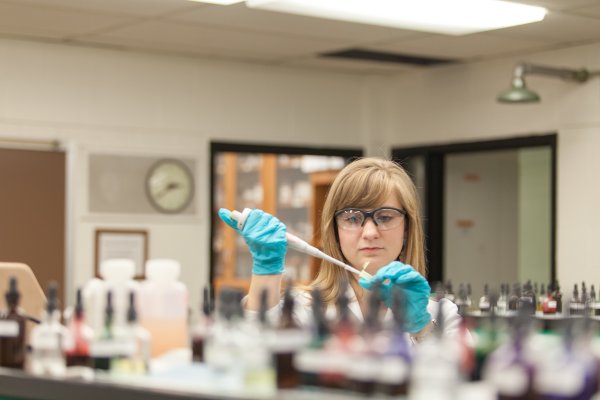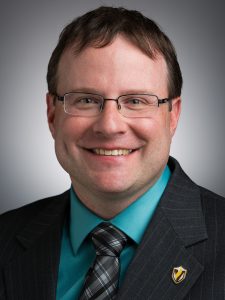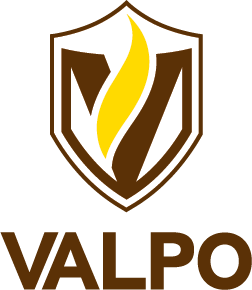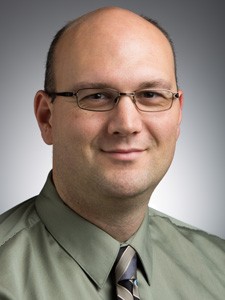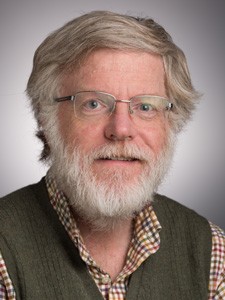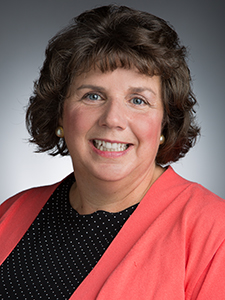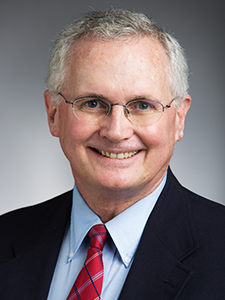Faculty and Staff
The pre-medical arts program aims to prepare students for the advanced coursework necessary to pursue medical occupations.
The pre-medical arts committee consists of seven faculty from the departments of biology, chemistry, and psychology whose goal is to help guide students in their preparation for professional school. The committee writes all letters of recommendation for health schools.
Robert Clark, Ph.D.
Assistant Professor of Chemistry
Neils Science Center, Room 111
219.464.5757
robert.clark@valpo.edu
Education
Ph.D. — University of Wisconsin-Madison (2005)
M.S. — University of Wisconsin-Madison (2001)
B.S. — Central Michigan University (1999)
Interests
Spectroscopic and biochemical studies to investigate structure/function relationships in gas-sensing heme proteins.
Thomas E. Goyne, Ph.D.
Assistant Professor of Chemistry
Neils Science Center, Room 239
219.464.5378 (phone)
219.464.5489 (fax)
thomas.goyne@valpo.edu
Education
Ph.D. — University of California-Los Angeles (1983)
B.S. — Union College (1978)
Interests
The role of chloramines and other reactive oxidants in killing of microbes by neutrophils.
Contributions
- Suzanne M. Furness-Green, Tracy R. Inskeep, Jennifer J. Starke, Lu Ping, Heather R. Greenleaf-Schumann and Thomas E. Goyne. “High Performance Liquid Chromatographic Analysis of Amino Acid- and Peptide-Derived Chloramines” Journal of Chromatographic Science 1998, 36, 227-236
- Thomas E. Goyne and David S. Sigman. “Nuclease Activity of 1,10-Phenanthroline-Copper Ion. Chemistry of Deoxyribose Oxidation” Journal of the American Chemical Society 1987, 109, 2846-2848
- Michio Kuwabara, Chun Yoon, Thomas Goyne, Theodore Thederahn, and David S. Sigman. “Nuclease Activity of 1,10-Phenanthroline-Copper Ion: Reaction with CGCGAATTCGCG and its Complexes with Netropsin and EcoRI” Biochemistry 1986, 25, 7041-7408
- Yasuhiko Araki, Diane C. Dobrowolski, Thomas E. Goyne, Douglas C. Hanson, Zhi Q. Jiang, Kenneth J. Lee, and Christopher S. Foote. “Chemistry of Singlet Oxygen. 47. 9,10-Dicyanoanthracene-Sensitized Photooxygenation of Alkyl-Substituted Olefins” Journal of the American Chemical Society 1984, 106, 4570-4576
- Christopher S. Foote, Thomas E. Goyne, and Robert I. Lehrer. “Assessment of Chlorination by Human Neutrophils” Nature 1983, 301, 715-716
Memberships
American Chemical Society, Council of Undergraduate Research, Midwestern Association of Chemistry Teachers in Liberal Arts Colleges (MACTLAC)
Recognitions
- UCLA Chemistry Department Teaching Assistant Awards – 1978-1979 and 1979-1980
- UCLA Department Fellowship – 1983
- NIH Institutional Traineeship in Tumor Biology – 1984
- NIH Institutional Traineeship in Carcinogenesis – 1986
- Outstanding Chemistry Lecturer, California State University-Long Beach – 1987-1988
(chosen by the CSULB chemistry students) - Award for Teaching Excellence at the Freshman Level – 1994
- Alpha Lambda Delta (freshman honor society)
Kevin L. Jantzi
Associate Professor of Chemistry
Neils Science Center, Room 240
219.464.5201 (phone)
219.464.5489 (fax)
kevin.jantzi@valpo.edu
Education
Ph.D. — University of Wisconsin-Madison (2004)
B.A. — Goshen College (1998)
Interests
- Use of palladium catalysts to generate small, highly functionalized rings
- Making molecules using readily available carbohydrates instead of using the nearly depleted petroleum reserves
Contributions
- K. L. Jantzi, I. A. Guzei, H. J. Reich, “Solution and Solid-State Structures of Lithiated Phenyloxazolines,”Organometallics 2006, 25, 75390-5395.
- K. L. Jantzi, C. L. Puckett, I. A. Guzei, H. J. Reich, “Solution Structure and Chelation Properties of 2-Thienyllithium Reagents,” Journal of Organic Chemistry 2005, 70, 7520-7529.
- H. J. Reich, W. S. Goldenberg, A. W. Sanders, K. L Jantzi, C. C. Tzschucke, “Amine- and Ether-Chelated Aryllithium Reagents – Structure and Dynamics,” Journal of the American Chemical Society 2003, 125, 3509-3521.
- C. R. Cornman, K. L. Jantzi, J. I. Wirgau, T. C. Stauffer, J. W. Kampf, P. D. Boyle, “Coordination Chemistry of a Tripodal S2ON Ligand: Syntheses, Structures, and Reactivity of the Molybdenum(VI) and Nickel(II) Complexes of Bis-(2-mercaptoethyl)-2-amino-4-methylphenol (H3btap) and Comparison to VVO(btap),” Inorganic Chemistry 1998, 37, 5851-5855.
Memberships
American Chemical Society, Council of Undergraduate Research
Jim Nelson, Ph.D.
Associate Professor of Psychology
Dickmeyer Hall, Room 209
219.464.5443
jim.nelson@valpo.edu
Education
M.S., Ph.D. – Washington State University (1983)
M.Div. – Fuller Theological Seminary (1981)
B.A. – Eastern Washington University (1976)
Biography
Jim Nelson, who joined the Valparaiso University faculty in 1987, serves as associate professor of psychology and a member of the Chinese-Japanese studies faculty. Professor Nelson trained as a clinical psychologist with interests in neuropsychology and cross-cultural psychology. He is a licensed psychologist in the state of Indiana. His current research interests focus on theoretical issues in psychology and the relationship between psychology and religion. He teaches abnormal psychology at the undergraduate and graduate level as well as classes in psychology and religion, adult development, and human neuropsychology. He has served as director of graduate counseling programs, has directed the Valpo China study program, and was a visiting scholar at UCLA and the Fuller Graduate School of Psychology in Pasadena, Calif. Professor Nelson, his wife, Jeanne Brown, and their children, Anthony and Teresa, enjoy family time as well as traveling in the United States and overseas.
Laura Rowe
Associate Professor of Chemistry
Neils Science Center 144
219.464.6255
laura.rowe@valpo.edu
Specialty
Bioanalytical chemistry
Education
Post-Doc – Cambridge University, U.K. (2009–2011)
Ph.D. in Bio-Analytical Chemistry – University of Kentucky (2008)
B.S. – University of Kentucky (2002)
Research Interests
Creating new fluorescent unnatural amino acids and evolving the translational machinery in E. coli to incorporate these unnatural amino acids into proteins, using various unnatural amino acids to make sensors and detection systems for important physiological analytes
Contributions
Patents:
- Daunert, Sylvia; Deo, Sapna, Dikici, Emre; Rowe, Laura. Aequorin and obelin mutants with different wavelengths and bioluminescence and their uses in screening inhibitors of HIV-1 protease, U.S. Pat. Appl. Publ., 2008, Patent No. US20050214776.
- Daunert, Sylvia; Joel, Smita; Turner, Kendrick; Rowe, Laura. Polypeptides, Systems, and Methods Useful for Detecting Glucose, 2011, Patent No. US20110117661.
- Daunert, Sylvia; Bachas, Leonidas; Haley, Boyd; Joel, Smita; Moschou, Elizabeth; Turner, Kendrick; Rowe, Laura; Wang, Ping; Siegrist, Jonathan; Madou, Marc. Device for Detection of Molecules of Interest, U.S. Provisional Patent Application Serial Nos 60/954,269 and 60/954,348, 2008, patent pending.
Book Chapters:
- Rowe, Laura; Teasley, Krystal; Qu, Xiaoge; Ensor, Mark; Deo, Sapna; Daunert, Sylvia. “Recombinant Aequorin Based Systems for Biomarker Analysis”, Handbook of Biosensors and Biochips, John Wiley & Sons, 2007.
- Rowe, Laura; El Khoury, Graziella; Lowe, Christopher. “Affinity Chromatography: A Historical and Prospective Overview”, Biopharmaceutical Production Technology, 225-282 2012.
- Dikici, Emre; Rowe, Laura; Moschou, Lisa; Rothert, Anna; Deo, Sapna; Daunert, Sylvia. “Luminescent Proteins: Applications in Microfluidics and Miniaturized Analytical Platforms”, Photoproteins in Bioanalysis, Wiley-VCH, 2006
Journal Articles:
- Qu, Xiaoge; Rowe, Laura; Dikici, Emre; Ensor, Mark; Daunert, Sylvia. “Thermostable Aequorin Mutants”, Bioanal. Chem 406 (23), 5639-5643, 2014.
- El Khoury, Graziella; Rowe, Laura; Lowe, Christopher. “Biomimetic affinity ligand for immunoglobulins based on the multicomponent Ugi reaction”, Methods in Molecular Biology, 800, 57-74, 2012.
- Rowe, Laura; Ensor, Mark; Mehl, Ryan; Daunert, Sylvia. “Modulating the bioluminescence emission of photoproteins by in vivo site-directed incorporation of non-natural amino acids”, ACS Chem. Biol 5 (5), 455-460, 2010, cover.
- Rowe, Laura; Dikici, Emre; Daunert, Sylvia. “Expanding the Analytical Potential of Bioluminescent Proteins”, Chem. 81 (21), 8655-9201, 2009, cover.
- Dikici, Emre; Qu, Xiaoge; Rowe, Laura; Millner, Lori; Logue, Courtney; Ensor, Mark; Deo, Sapna; Daunert, Sylvia. “Aequorin Variants with Improved Bioluminescence Properties”, PEDS, 22(4), 243-248, 2008.
- Rowe, Laura; Combs, Kelly; Ensor, Mark; Deo, Sapna; Daunert, Sylvia. “Analytical applications of semi-synthetic photoprotein mutants: a time-resolved bioluminescent assay”, Chem., 80 (22), 8470-8476, 2008.
- Rowe, Laura; Rothert, Anna; Logue, Courtney; Ensor, Mark; Deo, Sapna; Daunert, Sylvia. “Spectral tuning of photoproteins by partnering site-directed mutagenesis strategies with the incorporation of chromophore analogues”, PEDS, 21, 73-81, 2008.
- Rowe, Laura; Deo, Sapna; Mirasoli, Mara; Shofner, Josh; Daunert, Sylvia. “Homogeneous immunoassay for cortisol in saliva using the bioluminescent protein aequorin”, Bioconjugate Chem., 18 (6), 1772-1777, 2007.
- Doleman, Leslie; Davies, Logan; Rowe, Laura; Moschou, Lisa; Deo, Sapna; Daunert, Sylvia. “DNA hybridization assay for Plasmodium falciparum using the bioluminescent protein aequorin”, Chem., 79 (11), 4149-4153, 2007.
- Rowe, Laura; Deo, Sapna; Ensor, Mark; Daunert, Sylvia. “Bioluminescent Properties of an Obelin Mutant in Varying pH and Solvent Solutions”, Proceedings of Bioluminescence and Chemiluminescence Symposium 2006, World Scientific Publishing, 131-134, 2007.
- Rowe, Laura; Ensor, Mark; Daunert, Sylvia. “EF-hand Ca2+-binding bioluminescent proteins: effects of mutations and alternative divalent cations”, SPIE, 6449, 64490T/1-64490T/8, 2007.
- Rowe, Laura; Ensor, Mark; Scott, Daniel; Deo, Sapna; Daunert, Sylvia. “Genetically engineered luminescent proteins in biosensing”, SPIE, 6098, 6098H/1-6098H/9, 2006
Memberships
- American Chemical Society
- Chemists Without Borders
Grants
- Pittsburgh Conference Memorial National College Grant,Pittsburgh Conference, Instrument Grant, 2014 ($9,500)
Beth Scaglione-Sewell, Ph.D.
Associate Professor of Biology
Neils Science Center, Room 302
219.464.5390
beth.scaglionesewell@valpo.edu
Education
Ph.D. – Kansas State University (1992)
B.A – Simpson College (1985)
Interests
The regulation of growth and differentiation of cells. Specifically, Professor Scaglione-Sewell has been interested in regulators of the mammalian cell cycle that are adversely affected in colon cancer cell culture models. Techniques utilized in the laboratory include Western Blotting, Northern Blotting, cell culture, enzyme assays, and some electron microscopy.
Contributions
- “Review of the Aging of Physiological Systems.” In: Gerontological Nursing: Competencies for Care. – Plahuta, Janice, Hamrick-King, Jennifer and Beth Scaglione-Sewell. Ed. Kristen L. Mauk. Boston: Jones and Bartlett Publishers; 2010. pp.128-231.
- A Vitamin D3 analog induces a G1-Phase arrest in CaCo-2 cells by inhibiting Cdk2 and Cdk6: Roles of Cyclin E, p21Waf1 and P27Kip1., Endocrinology 141:3931-3939., (2000)
- Decreased PKC-alpha expression increases cellular proliferation and enhances the transformed phenotype of CaCo-2 cells, Cancer Research 58:1074-1081., (1998)
David W. Scupham, Ph.D.
Associate Professor of Biology and Department Chair
Neils Science Center, Room 304
219.464.5386
david.scupham@valpo.edu
Education
Ph.D. – Indiana University (1985)
B.A. – The University of Chicago (1975)
Biography
David Scupham and his students have studied the effects of naturally occurring suppressors of immune responsiveness in vitro. Since proliferation of murine lymphocytes is inhibited by the molecules under study, research in this laboratory is now focused on the molecular mechanism by which suppression occurs. Some of the techniques used in these studies include cell culture, agarose gel electrophoresis, and reverse transcription-polymerase chain reaction (RT-PCR).
Interests
- Molecular biology
- Molecular mechanisms for immune suppression in vitro
- Pedagogical research for the teaching laboratory
Contributions
- A.A. Westrick and D.W. Scupham (2011) Life After Expiration III: A Qualitative Comparison of Expired Restriction Endonucleases and Taq Polymerases to Their Unexpired Counterparts., Indiana Academy of Science, Programs and Abstracts 126, 50.
- J.A. Egge and D.W. Scupham (2009) Life After Expiration II: A Continuation Study on Effective Long-term Use of Biotech Reagents for the Teaching Laboratory., Indiana Academy of Science, Programs and Abstracts 125, 131-132.
- J.R. Foelber, H.S. Moebs, and D.W. Scupham. (2001) Life after Expiration: Effective Long Term Use of Biotech Reagents in the Teaching Laboratory., Indiana Academy of Science Programs and Abstracts, 117: 100.
- D.W. Scupham. (1993) Differential effects of oxysterols on interleukin-2 receptor expression and proliferation of murine splenic lymphocytes., The FASEB Journal 7 (4), A682.
Memberships
- Council on Undergraduate Research (CUR)
- Indiana Academy of Science (Vice-Chair, Science Education Section, 2011-2012)
- Indiana College Biology Teachers’ Association (Past President; Steering Committee Member)
